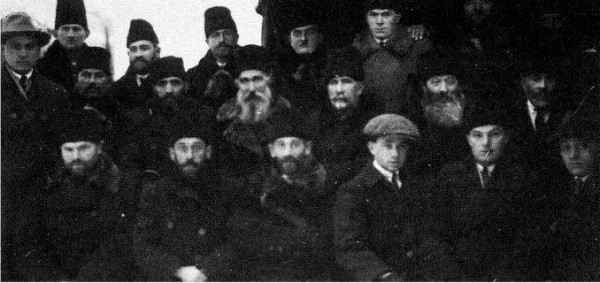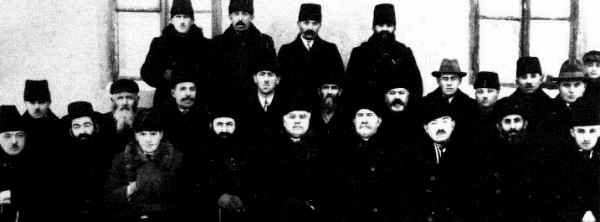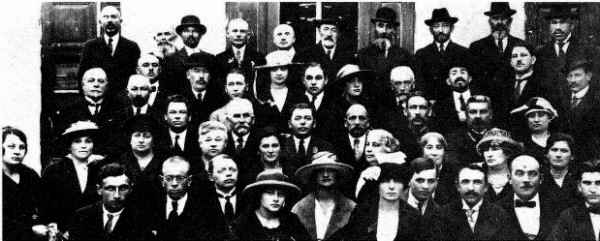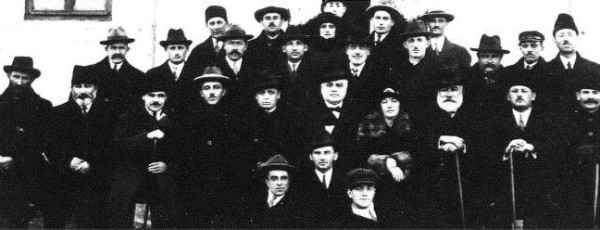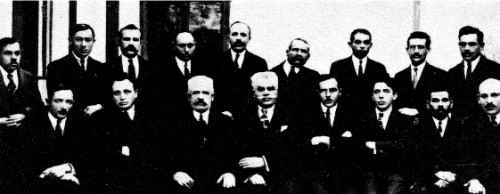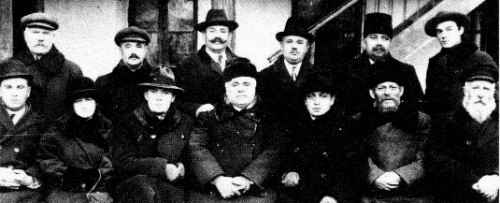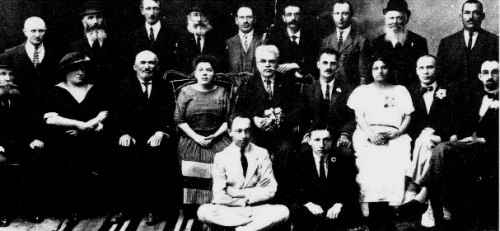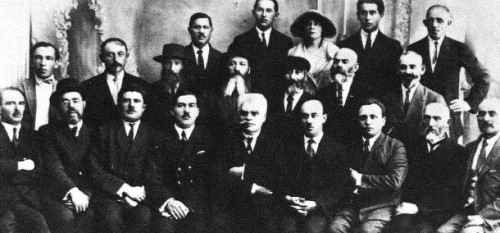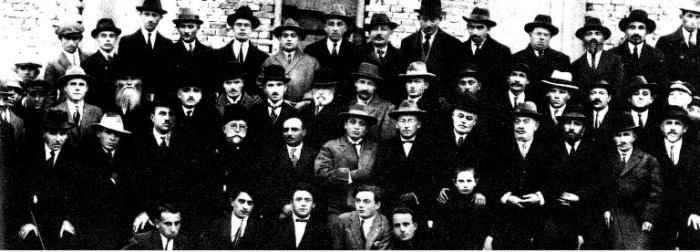[Page 121]
The Building of Eretz Israel {cont.}
The Visit of Colonel Josiah Wedgwood
The fundraising campaign of Keren Hayesod in 5689 (November 2, 1928) was opened with the visit of Colonel Josiah Wedgwood, a Labour Party member of the British Parliament. He stayed in Kishinev two days, on the 9 and 10 November. His visit was carefully planned and many events were scheduled for the 36 hour visit; an impressive effort for the organizers and for the guest.
A few days before the visit, the poet Shamai Pinsky, who was in Bucharest as the envoy of Keren Hayeson came to Kishinev to help with the preparations. Dr. Abraham Mi–Bashan served as the colonel's guide; in Kishinev his body guard was the honorary chairman, Advocate Sh. Rosenhauft. At the train station he was greeted by the Maccabi honour guard and orchestra and by the Military Governor of Kishinev, General Scrisoreanu; the mayor, Herman Pintie, Rabbi Y.L. Tzirelson, the chairman of the Zionist Federation, Sh. Berliand, representatives of the Zionist parties, youth organizations and numerous delegates from the province.
The two day programme included: visit with General Scrisoreanu, visit with Rabbi Tzirelson, lunch with I. Berger, the director of Keren Hayesod, visit at Maccabi, attendance at a Keren Hayesod meeting with delegates from the province, attendance at a closed meeting with the Revisionist Party, a reception at the City hall, meeting with the Pioneer Youth (Ha–Shomer ha–Tzair, Gordonia, He–Halutz ha–Tzair and Maccabi), meeting with members of Tzeirei Zion executive, reception at the Choral Synagogue, meeting with the press, festive lunch at the house of Alexander Zilberman, the Deputy mayor, assembly at the Express Theatre and finally, farewells at the train station on his way to Chernovits.
He spoke in German and at the end of his speech at the assembly at the Express Theatre he shouted: “Long live the Zionists.”
Wedgwood was very impressed from his meetings with the Bessarabian Jews and at the meeting with the youth leadership and said that he was impressed by the simple and sincere
[Page 122]
reception he received.
At the press conference he gave at the Lwow train station when leaving Romania he said that he was impressed by the Jews of Kishinev, even though he felt that most of the people did not understand his language. He liked the people because he saw that they know how to ask and are not ready to surrender.[12]
The fundraising of 1929 did not have the expected results. In the next summer, Bessarabia was hit by a big “blow from heaven” a severe drought, especially in the South and at the beginning of the winter thousands of families were destroyed by hunger and cold. The survey done by the editor of Undzer Tzeit, Zalman Rosenthal and by the “Joint” representative Jacob Leshintzsky for the Centre for the Famine Victims painted a terrifying picture.
Immediately they set up relief centres in the towns not plagued by the drought and within weeks they collected impressive sums of money, about half the funds of Keren Hayesod.
The fundraiser of 1930 also encountered difficulties because of the priorities of other projects. After the events on Tisha B'Av 1929 at the Western Wall and the Pogroms that followed, a series of protest meetings took place in most Bessarabian localities.
The management of the newspaper Undzer Tzeit called for a special fundraiser to help the communities devastated by famine and a few cities and town answered this call and large amounts were collected, i.e. in Romanovka collections reached 147, 470 Lei ( a sum equal to the Keren Hayesod donations). Also on Rosh Hodesh (beginning of the month) Elul the Chief Rabinate in Kishinev made an appeal to collect money in the synagogues and advertized in the weekly “Die Voch”.
They collected more that 300 thousand Lei (about 300 Sterling Pounds) that were transferred to Rabbi Kook and Rabbi Rosenfeld and the money collected by Undzer Tzeit, to Meir Dizengoff.
The Keren Hayesod regular activities faced difficulties due to all these parallel fundraisers in all Bessarabia.
The situation of Keren Hayesod started to improve when Sokolow visited Bessarabia in 5690 (1930). The Keren Hayesod benefited since then of the work
[Page 123]
of many non–Zionists, members of the Jewish Agency such as Dr. Yechezkel Muchnik, advocate Alexander Feinshtein and Tuviya Cohen.
The Zionists Revisionists who did not attend any of the events for Sokolow published an announcement in the newspapers stating that they do not have any animosity toward the Chairman Sokolow or towards the Keren Hayesod and that they will continue fundraising and helping the fund in the future.[13]
The following table shows the collections in the first half of 1930 as it was presented at the Central Committee meeting and published in “Undzer Tzeit.” The fundraising did not finish in Kishinev and they still had to visit the 20 localities that collected more than 900 thousand Lei the year before.
| a. |
39 localities |
Number of people 2,901 |
4,479,755 Lei |
| b. |
Kishinev donations |
Number of people 290 |
975,825 Lei |
| |
Total |
3,191 |
5,455,580 Lei |
| |
Cash donations |
|
3,329,282 Lei |
Because the Keren Hayesod figures are not as complete as the ones of Keren Kayemet the following table only shows the final amounts in Sterling Pounds that were sent to the main office in Jerusalem:
| 1921 |
6,729 £ |
| 1922 |
369 £ |
| 1923 |
2,355 £ |
| 1924 |
3,376 £ |
| 1925 |
2,407 £ |
| 1926 |
1,514 £ |
| 1927 |
2,812 £ |
| 1928 |
3,988 £ |
| 1929 |
1,899 £ |
| 1930 |
4,336 £ |
| Total |
29,782 £[14] |
[Page 124]
These are the details of the first decade of Keren Hayesod as found in the fragmented materials consulted by the authors. It was imposible to discover any serious materials about the second decade from 1931 on.
The situation of the Jews of Bessarabia is well known in those years: a poor agriculture, economic boycott from the German population of South Bessarabia, a tide of anti–Semitic parties and silence from the liberals or democrats. All that caused the economic situation to worsen and as a result the donations to the Keren Hayesod diminished considerably.
In 1935 Itzchak Berger left Bessarabia after he served for 8 years as director. His place was filled by the poet Shamai Pinsky, one of the important workers at the Zionist Federation in London. He was famous in the Regat because he knew how to captivate the audience with his language skills and style of his lectures.
The Urban population according
to the 1930 Census |
Old Romania 239,962 people |
Bessarabia 99,392 people |
Bucovina 68,772 people |
Transilvania 111,878 people |
| Amounts transferred in Liras |
Up to 31/3,
1923 |
7,955,02.01 |
8,453,14.05 |
944,09.10 |
179,01.03 |
| 1/4, 1923 – 31/3, 1925 |
30,820,13.06 |
6,194,03.06 |
4,316,10.11 |
1,568,10.06 |
| 1/4, 1925 – 31/3, 1927 |
33,110,19.09 |
3,119,07.06 |
5,458,17.05 |
4,220,18.01 |
| 1/4, 1927 – 30/6, 1930 |
45,466,11.03 |
11,849,00.03 |
11.309,13.10 |
10,744,16.06 |
| Total |
117,353,06.05 |
29,616,05.05 |
22,029,12.00 |
16,712,17.04 |
Clarifications on the table:
- The donations for Keren Hayesod came mostly form the urban population.
- Most of the villages in Bessarabia were included in the rural sector. The rural population numbered 160 thousand people and not 99 thousand.
- The gap between the donations in Romania and those of Bessarabia is explained by the strong economic situation in the Regat, where the Jews held key positions in the light and heavy industry and in the commerce (The 3 large cities: Bucharest, Jassy and Galatzi had a population of 130 thousand Jews). Bessarabia was poor and oppressed and during the Romanian rule did not enjoy any economic development.
[Page 125]
In January 1936 Pinsky arrived in Kishinev for the opening of the annual fundraising campaign which took place in the Express Theatre. With this occasion, a protest was organized against the British Mandate Rule which wanted to impose a Legislative Council in Eretz Israel. The following honoured guests participated at the assembly: the Chief Rabbi Y.L. Tzirelson, the chairman of the Jewish Community, Advocate Karl Shteinberg and Advocate Alexander Feinshtein, a member of the Jewish Agency.
Rabbi Tzirelson followed with a speech after the opening address of the chairman, Shlomo Berliand.
He said: “This is not a meeting of protest; this is a meeting of sounding the alarm, the alarm of the people against his oppresors. You do not protest the assassins; you raise your voice and ask for help. If we can't protect our right like Bar Kochba in the past, we have to raise our alarm voice to shudder the entire humanity. Bernée said: “The wold is big, but its people are insignificant, unfortunately. By its action Britain is unlawfully robbing us; we have to raise our voices to reach the world in order for them to stop denying us our rights.”
The next two speakers were K. Shteinberg and A. Feinshtein, both respected members of the community. The last speaker was Shamai Pinsky and he expressed his delight to be together with people who share the common dream of redemption even if he does not believe in protests. He urged the audience to turn their attention to themselves, especially in this year when Keren Hayesod is celebrating its 15th anniversary. He stated that the Keren Hayesod collected only 5 million Lei instead of the projected 25 million needed for the development of Eretz Israel and its settlements.
At the assembly it was decided to send a letter to the British Government of protest against the Legislative Council and it was also decided to call on the community to increase the level of donations.
The Visit of Rabbi Yehudah Leib Fishman (Maimon)
Rabbi Y.L. Fishman, a member of the Zionist leadership came to Kishinev on 9 Adar 5696 (March 3, 1936) to participate to a business conference of Keren Hayesod. 40 delegates from 28 towns participated at the conference. Fishman visited Rabbi Tzireslon on the same day before the conference opened at the Choral Synagogue.
[Page 126]
Chairman Shlomo Berliand opened the meeting and Rabbi Itzchak Finkelstein from United Communities blessed the guest and the audience. The guest lectured about the situation in Eretz Israel, and Shamai Pinsky gave the closing address.
The following people were elected to the leadership: Rabbi Levi Shternberg (Dumbraveni), Israel Blank (Bender), Pinchas Levtov (Beltz) and Idel Ukolist (Romanovka).
The following people were elected secretaries of the council: Dr. Shniur Itzkovich–Itzchaki (Bolgrad) and Joseph Krasnoshensky (Calarashi).
The same day was dedicated to reports and surveys of the local activities and discussions on the future of the organization. In the evening the guest lectured on the situation in Eretz Israel behind closed doors and decisions were proposed for voting.
A council of 46 members (25 from Kishinev) and an executive committee of 21 were elected.[15]
Despite all these efforts, the Keren Hayesod donations remained under the level of those from the earlier decade. The political events caused by the ascent of the anti–Semitic government created a lot of difficulties. Pinsky was subjected to many travel restrictions and because he was a foreigner he was unable to extend his stay in Romania; he was forced to leave his work in Romania in 1938.
The political crisis caused other problems for the Jewish community: the newspaper Undzer Tzeit, the only daily newspaper in Yiddish in Romania, had to fold after 16 years of existence. The Bulletins published after that by the Funds management, Binian Ha–Aretz (Homeland Building) could not fulfill the spiritual needs of the community and the contact between the centre and the provincial localities was severed.
Moreover, the funds were plagued by obstacles the entire year 1938. From September to November 1938 the authorities ordered the funds to stop, exactly during the High Holidays and the harvest which were the best times for fundraising.
The 44 days of the Goga–Cuza government left the Jewish Community
[Page 127]
in a state of fear, poverty and depression.
The Jewish commerce was shut down and the monetary crisis intensified. The traffic on the roads became very light and panic reigned all over. The secret service raided the Keren Hayesod office and all the ledgers, correspondence and receipts were seized for a few weeks. To top all that, the authorities started to check on the citizenship rights of the Jews which caused never ending worries and lack of will to donate.
Even when the Goga–Cuza government fell and the King Carol assumed total power the situation of the Jewish community did not change. Now Nazi Germany pressured Romania to intensify the anti–Semitic policies toward the Jews.
In order to cut the expenses, the management of Keren Hayesod led by Shlomo Berliand decided to run the organization without outside help at the beginning of 1939. This did not please the Mizrachi and the Binian Ha–Aretz which considered it a weakening of the activities in the provincial localities.
But when they elected a special city committee of 40 people led by Alexander Feinshtein, Abraham Ortenberg, Philip Ginzberg, Ben–Zion Weinshtein, Abraham Nemirovsky and advocate Itzchak Koren, the activities increased in Kishinev. The new campaign started under the slogan “Keren Hayesod – Saviour of the People.”
This call reached the hearts of the community and the donations topped one million Lei by the spring, similar to the Keren Kayemet that collected more than one million Lei.[16]
The campaign of 1940 (until June 1940 when Bessarabia was annexed by the Soviet Union) had a great success even in the provincial localities. The difficult situation of the Polish Jewry at the beginning of WWII deeply shook the Jews of Bessarabia and they felt that all efforts should be directed to the building of Eretz Israel. This common decision was achieved at the Keren Hayesod Congress in January 1940 with the participation of Dr. N. Geler from Jerusalem.
The new Central Committe was elected with Shlomo Berliand as Chairman, Advocate Alexander Feinshtein, a very well known non–aligned activist, as Vice–Chairman; two representatives of Mizrachi – Leib Alexandovsky and Ben–Zion Weinshtein, and Advocate Philip Ginzberg (Binian Ha–Aretz and one representative of the General Zionists – Abraham Nemirovsky. It was also decided to search for a secretary who
[Page 128]
will organize the activities.
Dr. Geler wrote in his report to the Central Committee on January 10, 1940 the following:
“Binian Ha–Aretz” salvaged the situation with their concessions. In general we can be satisfied with the results of the meeting wich left a very good impression on all. Many representatives showed their dedication and the will to get better resuts. Bessarabia possesses a wonderful manpower and with the right management it will donate more in the future.”
Conclusions:
This was the last voice of the organized Bessarabia Jewry before it fell under a tyrannical hand. Here is a summary of the Keren Hayesod donations during its 20 years activity in Bessarabia. There are no detailed informations about the amounts in Romanian currency; therefore we had to use their method of reporting.
- During the first decade from 1921 to the end of 1930, Bessarabia transferred to the Head Office in Jerusalem the sum of 29,782 Sterling Pounds, about 24 million Lei.[17] The local expenses reached about 30%; therefore the total donations from Bessarabia were about 34 million Lei.
- The only data available for the second decade (1931–1940) reflects the donations only from 1938 and 1939:
1938: Pledges – 1,623,050 Lei – Proceeds – 1,250,590 (cash)[18] (77%);
[Page 128a]
|
|
Photograph no. 32: The Kishinev delegation with members of the Executive Committee
of Keren Hayesod in Vertujeni, 1924
From bottom to top:
Row 1, from right to left: the teacher Sh. Landa, I. Shlafman, the teacher I. Vinitzky, Sh. Kubernik, M. Bronshtein, N. Shtutman,
Row 2, sitting: Z. Zinger, Ab. Vinitzky, engineer Dov Kliman (delegate), Rabbi I.Sh. Bronshtein, A. Romov, Zibenberg, P. Shtutman (standing)
Row 3, standing: Z. Flitman, K. Tzukerman, Az. Dubinsky (delegate), Ch. Shichmanter, Al. Goldshtein, the teacher Z. Zaken, I. Zaltzman. |
|
|
Photograph no. 33: The delegation with the Excutive Committee
of Keren Hayeson of Markuleshti, 1924
From the bottom to the top:
Row 1, from right to left: I. Tomarkin, Al. Kotik, Sh. Hilleles, Dov Klimker, Dr. I. Sapir, Rabbi L. Shternberg, Az. Dubinsky (5 delegates), Rabbi I. Yetom, Dr. I. Geler,
Row 2: Ch. Broitman, Sh. Eizenberg, P. Lerner, I. Goldshtein, A. Tesler, L. Midler, I. Shwartzburd, A. Weissbuch, Sh. Kupershtein, Unknown,
Row 3, standing: M. Yaffe, A. Triff, N. Greenberg, Unknown. |
[Page 128b]
|
|
Photograph no. 34: Dr. M. Shwartzman with the Executive Committee
of Keren Hayesod,
Bender, 1921
From bottom to top
Row 1, from right to left: Unknown, Goldenfan, I. Kornfeld, Z. Shneierson, Unknown, A. Shperling (Dobosarsky), Bortnik, Dr. Yaroslavsky, Ch. Glass, I. Kushnir
Row 2: Unknown, I. Blank, Molman, Tzwi Cohen, Dr. Michael Shwartzman, A. Broida, Unknown, L. Yanishevsky, Goldshtein, Tz. Shwartzman, Unknown, Unknown, M. Shtern, Ch. Postman, Bortnik, Ch. Landwerk, D. Gurpel, I. I. Ochiakovsky. |
|
|
Photograph no. 35: The Kishinev delegation with the Executive Committee
of Keren Hayesod,
Romanovka, 5685 (1925)
From bottom to top:
On the floor from right to left: P. Mesharet (Mishori), M. Rosenblat, A. Kishinovsky.
Row 1, sitting: I. Gobermna, Yaroslavsky, M. Oculist, Mrs. Kleiman, Dr. I. Sapir, M. Segal (2 delegates), Averbuch, Dr. Sverdlov, I. Oculist, Ch. Tz. Gitterman,
Row 2, standing: R. Handelman, D. Klinger, B. Berman, N. Chobrochka, A. Zonis, S. Feinshtein (Bronfman), M. Reznik, Sh. Oculist. |
[Page 128c]
|
|
Photograph no. 36: The Kishinev delegation with the Executive Committee
of Keren Hayesod of
Akkerman, 1924
From right to left, sitting: M. Helman, M. Staretz, I. Skwirsky, I. Berger, Dr. I. Sapir, M. Milshtein, M. Segal, Dr. Sh. Tzarling,
Standing: B. Gecht, Sh. Shternshis, V. Gordon, Z. Gladshtein, A. Kaplansky, I. Aharonovich, L. Stambul, I. Serper, I. Rivkin. |
|
|
Photograph no. 37: The Kishinev delegation with the Executive Committee
of Keren Hayesod
of Tarutina, 1924
From right to left, sitting: I.K. Rosenberg, I.L. Baratz, M. Segal, Dr. I. Sapir, Ab. Dubinsky (3 delegates), Mrs. Krasiuk, Dr. Krasiuk,
Standing: M. Levit, AB. Roitberg, Ish. Itzkovich, Al. Berger, Reznik |
|
|
Photograph no. 38: The Kishinev delegation with the Executive Committee
of Keren Hayesod of Killiya, June 1923
From right to left sitting: Z. Fradkin, Dr. N. Rabinovich, Ch. Reidman, K. Leventon, Dr. I. Sapir, Yetty Kitzis, Wilhelm Kitzis, Sh. Leventon, G. Baranovsky,
Standing: Zelikovich, I. Goldman, I. Chaimovich, B. Kalmanson, Markus Kitzis, P. Lachmanovich, Pradis, B. Fefferman, R. Safris,
Sitting on the floor: Leizerovich, A. Glukhoi |
[Page 128d]
|
|
Photograph no. 39: The Kishinev delegation with the Executive Committee
of Keren Hayesod of Khotin, 1924/1925
From right to left, sitting: 2 Unknowns, M. Segal, D. Reblovsky, Dr. I. Sapir, I. Wasserman (delegates), Joseph Appleboim, A.Z. Melamed, Unknowns |
|
|
Photograph no. 40: The Kishinev delegation with the Executive Committee
of Keren Hayesod of Bricheni, 1924
From bottom to top, from right to left
On the floor: Sh. Cherkis, Sh. Gebilder, I. Lerner, Unknown, M. Cherkis
Row 1, sitting: Unknown, I. Cherkis, Ch. Gold, Ab. Ber'g, M. Viziltir, Tz. Weinshtein, M. Segal (2 delegates), Dr. I. Shor, Dr. J. Bernstein–Cohen, Nathan Lerner, Az. Dubinsky, B. Reznik, Unknown,
Row 2 standing: 3 Unknowns, H. Vertikovsky, 2 Unknowns, D. Lerner, Sh. Feldshar, A. Ber'g, Rabbi M. Gibelder, Sh. Kilimnik, Ef. Tshak, 5 Unknowns
Row 3, standing: A. Krasilchik, Unknown, I. Vertikovsky, P. Shneider, Unknown, M. Tzam, Unknown, N.B. Rechter, I. Shteinhouse (Amitzur), B. Bichuch, L. Bari, 2 unknown |
[Page 129]
1939: Pledges – 3,122,840 Lei, cash proceeds 2,519, 632 (80%)
Due to the dire situation created by the Romanian annexation of Bessarabia in the 1930s, the collections diminished by one third compared with the previous period, but the total amount collected in these years still reached 22 million Lei.
- The total amount donated by the Jews of Bessarabia to Keren Hayesod reached more than 56 million Lei!
It's important to remember that the donations of the Jews of Bessarabia should not be measured entirely on the high exchange rate of the Sterling Pound. It's more important to measure them on the efforts that were made by this impoverished population to collect almost 60 million Lei, a large amount considering their difficult economic situation.
This is in addition to the creative power and the pioneer spirit that the Jews of Bessarabia contributed to the building of Eretz Israel.
The following people served as managers of Keren Hayesod in Bessarabia: 1921 – Dr. M. Shwartzman; 1923–1925 – Dr. Joseph Sapir; 1926–1927 Dr. Jacob Wasserman, 1927–1935 – Itzchak Berger; and 1936– 1939 – Shamai Pinsky.
The following people assisted with the operation during various periods: Joseph Barafael, Chaim Greenberg, Dr. Yehudah L. Levinsky, Zeev Tiutman, Israel Trivush, Yeshayahu Klinov (secretary), Chaim Shorer, Joseph B. Shechtman (on the first year of Keren Hayesod), Dr. Emanuel Ovlesvansky and Shamai Pinsky.
The full time employees were: B. Gichku, Ezra Dubinsky (trainer and secretary), I. Danobich, Eliezer Drachlis (secretary), Nachman Huberman, Jacob Wasserman (head secretary, then manager), Leah Vidrovich (The Jewellery Fund), Zadok Weinshtein, Meir Zak (HaEzrachi), Michael Yachinson, Tzvi Cohen (secretary, trainer) Yehezkel Landoy, Joseph Lerner (Liron), Matetiyahu Segal, Israel Skwirsky, Zalman Pradnik, B. Karpin, Michael
[Page 130]
Kotliar, engineer Dov Klimker (Eretz Israel), Dov Rablesky, Gershon Shterman and others.
Beside Dr. Bernstein–Cohen, the following activists visited localities in Bessarabia: Shlomo Berliand (from 1926, Chairman of the Zionist Federation and Chairman of the Keren Hayesod in Bessarabia), Tzvi Bonfeld, Rabbi Shmuel Beltzen and his son Ben–Zion, Leib and Dr. Pinkhas Beltzen, Leib Glantz, Shlomo Greenberg, Tzvi Torkanovsky, advocate Michael Landau, Rabbi Abraham Polinkovsky and Zalman Rosenthal. At the end of 1930s – advocate Itzchak Koren – Kishinev, Mendel Masis – Beltz, Mendel Davidson – Itzchak Hitron, Rabbi Mordechai Shochetman – Soroca, Rabbi Levi Shternberg – Dumbraveni, Rabbi Joseph Wertheim – Bender, Zeev Agser (Igret) – Secureni, Hilel Dubrov – Edinetz, Joseph Appelboim –Khotin, Jacob Motniak – Ismail and others.
The following activists of Keren Hayesod in Kishinev deserve mentioning: Abraham Ortenberg, Leib Alexandrovsky, engineer Joseph Beigelman, Israel Berman, advocate P. Gintzberg, Ben–Zion Weishtein, Khaim Cohen, Joseph Cohen, Dr. Yehezkel Muchnik, Abraham Nemirovsky, advocate Alexander Feinshtein, Abraham Koren and others.
Footnotes
- Undzer Tzeit. No. 1860, November 18, 1928. Return
- Undzer Tzeit, No 2180, December 16, 1929. Return
- From notes of M. Usoskin, director of the United Fundraising Campaign The following figures show the transfers of funds to the Keren Hayesod from each of the regions of Romania as published in the report to the 15th Zionist Congress of 1927 and reprinted in Ha–Olam (The World) 48, page 891–2 of November 4, 1930. Also some data about the Jewish urban population in Romania: Return
- Representatives from Kishinev: S. Berliand, Abraham Ortenberg, Leib Alexandrovsky, Ben–Zion Weinshtein, Chaim Cohen, Yechezkel Manzon, Abraham Nemirovsky, Shabtai Polinkovsky, Advocate Alexander Feinshtein, Issachar Pinchovsky, Itzchak Finkelevich, David Chervinsky, Zalman Rosenthal. From the provincial towns: Zeev Igret (Secureni), Israel Blank (Bender), Jacob Berger (Akkerman), Eliezer Vinitzky (Soroca), Pinchas Levtov (Beltz), David Fistrov (Bender), Rabbi Levi Shternberg (Dumbraveni) Return
- See in the Appendix [Page 326] The Circular from the National Office. Return
- The exchange was approximately 800 Lei to 1 Sterling Pound. The black market exchange in the summer of 1921 was 500 – 600 Lei and at the end of 1930 it was 1,200 Lei. The official exchange after the stabilization of the currency in Romania was set in February 1929 at 818,588 Lei, but in general it was difficult to transfer the money officially. Return
- The decrease in donations in 1938 was a result of the rise to power of the Goga–Cuza anti–Semitic government and the prohibitions they imposed on the funds activities. Although this government lasted only 40 days it succeeded to shake the political and economical situation of the country and to establish anti Jewish policies. This caused a decline in the economic situation of the Jews and it deeply affected the power to donate. Return
[Page 131]
Bank Hapoalim
The success of the first fundraising campaign for the Keren Hayesod in Bessarabia and the dedication of the Jewish community to the building of Eretz Israel encouraged the activists to issue bonds of the Bank Hapoalim which was established in 1921.
The members of the Tzeirei Zion Central Committee were given the task to visit a number of localities in order to promote this new initiative. This first round was deemed very successful.
In April 1922 Nachum Tversky came to Kishinev as the banks special representative in order to enlarge the enterprise. Together with Nachum Roitman, chairman of the Union of Jewish Cooperatives, who became the chairman, Tversky founded a special committee of representatives of Tzeirei Zion, General Zionists and independents.
They published in the Erd und Arbeit of April 30, 1922 the outline of the bank's program and an appeal to the people of Bessarabia.[1] The appeal was successful and they sold almost 2,000 bonds. The activists visited many localities in Bessarabia and Romania – Leib Glantz – Ungheni, Beltz and together with N. Tversky in Bender; Akiva Globman (Govrin) – Novoselitza; Grubman – Leova, Shmuel Yasky – Reni, Michael Landau – Harlau; Asher Koralnik Beltz, Botoshani, Soroca, David Rablesky –Ismailia, Artzig, Romanovka.
When Jacob Apter visited Kishinev at the beginning of 5684 (1924) the number of bonds sold reached 2,200.[2]
Apter continued to Bucharest where the number of bonds sold reached 3,000.[3]
Appeal for the Eretz Israel Workers Fund
The economical crisis in Eretz Israel 1926–28, especially after the immigration of 1925, known as the 4th Aliyah (4th Immigration), the unemployment and the “Assistance” project that had
[Page 132]
to assist the unemployed caused deep desperation among the population in the Diaspora which was waiting to immigrate and to escape their own misfortunes.
The Union workers in Eretz Israel understood that it is necessary to start an information campaign and Z. Feinshtein and H. Shorer were sent to Kishinev in January 1928. They were received warmly by the representatives of the Zionist Federation and the Youth organizations.
Shorer declared that they did not come to lament the crisis that especially affected the workers; they came to encourage the Diaspora that there are many accomplishments in the settlement and absorbtion of the immigrants.
Feinshtein gave information about the many aspects of the crisis and about the bid emigration from Eretz Israel despite the many achievements in agriculture sector and the development of the cooperatives in some industries. The main cause of the crisis was the criminal politicies of the British Mandatory Government towards the immigration. They stressed that there are many possibilities to solve the crisis, but first they have to stop the panic that overpowered the Jewish street.
Over the next 2 days there was a meeting chaired by I. Sokolovsky from the Central Committee to donate the proceeds to the Eretz Israel Workers Fund and the Bank Hapoalim in order to assist the workers to end the crisis. A large sum was collected on the spot and it was also decided to appeal to the rest of Bessarabia localities for help.
The two guests participated at the Fifth HeHalutz Congress in Jassy on the January 28, together with Eliyahu Dobkin, the chairman of International HeHalutz and they encouraged greatly the participants to overcome their fears. In the next few weeks the special committee collected more than half a million Lei for the Union organizations.
Footnotes
- The following signed the appeal: Nachum Roitman, Dr. Eliyahu Epshtein (Independents), Shlomo Berliand and Yehezkel Manzon General Zionists, Leib Trachtenberg, Asher Koralnik, Eliyahu Ortenberg, Leib Glantz, Israel Skwirsky and David Rablesky (Tzeirei Zion) and Nachum Tversky, the Bank representative Return
- Ha–Olam (the World), 19, 20 Nisan, 5684 Return
- Report to the Congress in 5685, page 391. Return
[Page 133]
The National Library in Jerusalem campaign
At the end of 5688 (1928), the Central Committee of Tarbut empowered Dr. Asher Golshtein to organize a campaign for the National Library which functioned near the Hebrew University in Jerusalem. He was joined by Yiuly Greenberg, Nataniel Averbuch, Mendel Davidson, David Vinitzky, Isar Rabinovich and I. Shlichovoy (Shiloah).
In the Intermediary days of Suchot 5689 (1929) at the meeting of the University Board a committee was established to collect materials and money for the Library.
On Erev Pesach (May 2, 1929) at the Tarbut meeting they presented their accomplishments. They collected a 300 year old Talmud Bavli from Amsterdam, year 5404 (1644) that escaped the Russian censor, an album of pictures from the 1903 Pogrom, a present from Mrs. Tashker in memory of her late husband[1]; important historical documents from the archive of Rabbi Tzirelson – an invitiation in Russian to the reception given by the Tsar Nicolai II at the Winter Palace in Petersburg, a ticket in Romanian to the celebration with the occasion of the Annexation of Bessarabia to Romania with the participation of King Ferdinand; the minutes of the Council of Rabbis meeting in Peterburg, the Council which was assembled by the minister Plehve in 1909–1910 under the leadership of Rabbi Tzirelson. Many lawyers and rabbis attended in order to prepare the laws governing the Jews in Russia (according to the specialists this is the only copy that exists of this important historical document); the letters of Ahad Ha–Am; of Gottlober and Shalom Aleichem – a gift from Z. Barchash (known as Shimek) the director of the Talmud Torah of Kishinev and a childhood friend of Shalom Aleichem from Perislav and many writings of Shmakov, Purishkevich, Kuze and others.
Rabbi Tzirelson, the honorary chairman of the Library committee addressed the meeting by thanking the members for their important work for
[Page 134]
the Library “which is the the expression of the will of the People of the Book to adorn with books the Nation of Books.” The chairman, Dr. Goldshtein and Itzchak Berger from the Keren Hayesod also spoke at the meeting. Dr. Moshe Slutzky opened the “The Massacre Scroll” and remembered the days of the Pogrom. Z. Barchash told about his childhood and his friendship with Shalom Aleichem.[2]
On Pessah eve of 5790 (1930) Rabbi Tzirelson participated to another festive meeting of the Library Committee. He did not pay any attention to the fact that the leadership of the Agudah Party were unhappy with his remarks about the Library and the University.[3] The Library Committee possessed a new collection of rare books to be sent shortly to the National Library. The collection was displayed for the participants to view and it included:
[Page 135]
- The scientific library of Dr. Itzchak M. Krasilshchik, z”l, head of the Bioentomology of the “Zemstvo” in Kishinev at the beginning of the 20th Century and editor of its publications.[4] In the collection there are 500 books and 1600 publications in Russian, French, German, Hungarian, Italian, Greek, Gruzini, etc. and also the book he authored. There are many manuscripts of work that were not published yet. The professor worked in the 1880s in the Caucaz and studied the Phylloxera and is considered a very important specialist in his field.
- A large collection of rare books and an old register of the Burial Society of Bender.
- The writing of Rabbi Tzirelson, his speeches to the Parliament and to the Senate in Romania which are testimonies to the social and political life in Bessarabia, his correspondence, etc.
- Important documents from the first days of the Annexation by Romania
- Letters from rabbis and writers: Yehudah Shteinberg, scholars from Chernovits, Skvyra and Savran.
- Proceedings from Kishinev trials of 1820, among them a few Jewish trials and the punishments “40 lashes in the public eye and exile to Siberia” (This material was discovered by Yiuly Greenberg when he distributed the blue boxes to a grocery store. This archival material was used to package groceries!)
The Chairman, Dr. Goldshein, proposed to declare the holiday of Pessah “The Library Week” and stressed the importance of the Library as a repository of knowledge from around the world and on all languages.
[Page 136]
Rabbi Tzirelson said the “The National Library will show the entire world the existence of the Jewish Nation and that's why the Library was built on Har Ha–Tzofim, the symbol of the eternity of the Jewish people; from where we look to the present, to the past and to the future.”
Itzchak Berger presented a summary of the cultural life of the Jewish people and declared “Universal culture and Jewish culture are expressed in the National Library in Jerusalem, that collects under its roof the treasures of Judaism and the world as one” Dr. I. Muchnik (later elected to the Jewish Agency – Sochnut) recalled the life and his friendship with Dr. Krasilshchik whose family donated his scientific library.[5]
Footnotes
- Part of the photographs were published in the book “The Kishinev Pogrom” edited by H. Shorer, Y. Koren and D. Vinitzky, published by the International Association of Bessarabian Jews, 5723 (1963) Return
- Undzer Tzeit, no. 1993, May 4, 1929; Ha–Olam 23, June 7, 1929 Written by Israel (probably) Weinshtein. Return
- In a letter to Rabbi Tzirelson from Vienna, dated 2 Tamuz 5689 (1929), we read: “The press here reported that you gave a big speech about the importance of the Hebrew University and the Library and we wonder why, you, as the Head of the Agudat Israel Party praise the University and advise the religious community to contribute to the Library. Please tell us where did this idea come from and on what it's based? In a second letter from Jerusalem, 8 Tamuz 5689 (1929) to Rabbi Tzirelson we read again: My friends in the Holy City gave me this unpleasant task and I deliver it to you: For a while now the Keren Hayesod and Keren Kayemet publishes a brochure entitled the Echo (ha–Hed). The editor is a liberal who relentlessly persecutes the Religious community. The scope of this brochure is to instill the KK'I and the KY'I ideas among the religious population, but the editor and the writers are hiding the real purpose of the organizations and they succeeded to deceive many of us. I saw that by myself!
This is the second time that they published your article, first in the Pesach issue and now again under the title
“The Importance of the National Library in Jerusalem”. We think that it is not written by you and it is a ploy to give a religious colour to their publication. I will not argue about the Library, but I want to point out to you that they took the love for Zion and Israel and they covered it in their ideology. It is true that the library is important and that it needs to collect books on all subjects, but we think that this library in Jerusalem is a liberal place. Please, esteemed Rabbi, excuse me if I dare to write to you, but we would like to know if you wrote these articles in the Echo. Sincerely and respectfully, Moshe Glikman–Porush.” Return
- History of Kishinev (Istoriya Kishineva), Kishinev, Cartea Moldoveneasca, 1966, 173p. Return
- Ha–Olam (the World) vol. 13, May 1930 – report by Isar Rabinovich. In the Ha–Olam, Vol 38, of September 16, there is a note that the Library received the donations. Return
This material is made available by JewishGen, Inc.
and the Yizkor Book Project for the purpose of
fulfilling our
mission of disseminating information about the Holocaust and
destroyed Jewish communities.
This material may not be copied,
sold or bartered without JewishGen, Inc.'s permission. Rights may be
reserved by the copyright holder.
JewishGen, Inc. makes no representations regarding the accuracy of
the translation. The reader may wish to refer to the original material
for verification.
JewishGen is not responsible for inaccuracies or omissions in the original work and cannot rewrite or edit the text to correct inaccuracies and/or omissions.
Our mission is to produce a translation of the original work and we cannot verify the accuracy of statements or alter facts cited.
 The Jews in Bessarabia
The Jews in Bessarabia
 Yizkor Book Project
Yizkor Book Project
 JewishGen Home Page
JewishGen Home Page
Yizkor Book Director, Lance Ackerfeld
This web page created by Jason Hallgarten
Copyright © 1999-2025 by JewishGen, Inc.
Updated 10 Aug 2020 by JH
